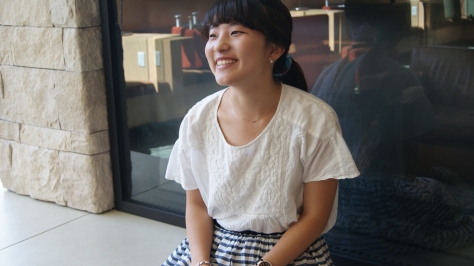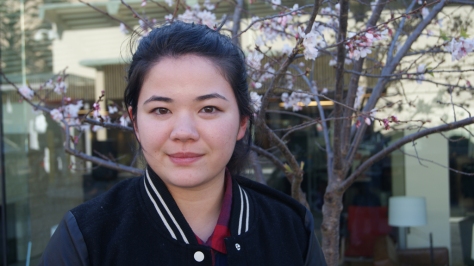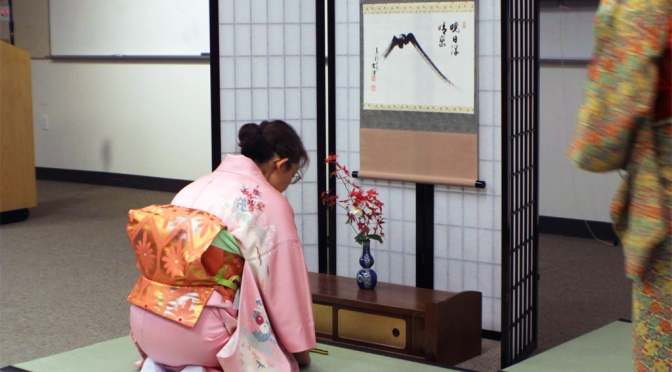Emily Pinnell-Stewart
Staff Writer
In Japan, Hanami (meaning “flower viewing”) is the traditional custom of gathering with family, friends, and coworkers to picnic under cherry blossom, or Sakura, trees. This cherished practice has now become known and celebrated throughout the world as well. San Francisco holds one of the largest Cherry Blossom Festivals in the United States, officially known as the Northern California Cherry Blossom Festival. Though it’s known as an exciting festival full of cultural performances, beautiful fashion, and great food, how illustrative it is of actual Japanese expression is unclear.
“For me, it’s a family thing,” says junior English Language major and Jeep Program student Mizuki Ota. She fondly remembers her mother waking up early to prepare lunch that the family would later share under the blossoming trees. In Japan, because the cherry trees only blossom for about a week, getting a good viewing spot is very competitive. Some people come days in advance to claim a seating area, and there is even a blooming forecast to inform people of when and where trees are blossoming.

However, here in SF, the festival is less intimate with a larger and louder celebration. One student, sophomore International Studies major Wesley Yee, is affiliated with the Japanese Cultural and Community Center of Northern California, which volunteers at the cherry blossom festival, orchestrated by the Japantown Merchants Association. “The way we set it up here is more aligned with Japan’s summer festivals,” says Yee. “We kinda jump at any chance to have a big community gathering. The Japanese American community here are very close-knit, and we love any opportunity to get together.” He explains how most of the traffic that Japantown gets is from younger people interested in contemporary Japanese fashion and media, such as cosplay and anime. Therefore, the festival is catered to that crowd.
Apparently, it isn’t just in the states where this contemporary Japanese culture is popular. “The tourists cosplaying fit in more than I do in some areas of Tokyo, which is a little weird,” says freshman international student and Design major, Ema Matsumura. “What’s funny, actually, is that people who wear traditional Japanese clothing, like Kimono or Yukata, stand out more than the people cosplaying or something. It’s more rare to see [them] walking around these days.”
Because of this juxtaposition between traditional and modern, there is a slight cultural divide between the older generation and the younger generation of Japanese Americans in the U.S. “Most of the older generation Japanese people in the bay area, they came here before WWII. Because of the discrimination they faced, they raised their children to be more westernized. They wanted their kids to be raised as Americans so they would be respected as Americans,” says Yee. Another student, senior Biology and Japanese Studies double major Amanda Tsuhako, explained how as a third generation Japanese American, she’s had to learn and study a lot about her own culture. “I’ve been studying Japanese for ten years. Now I want to eventually live in Japan. I’ve found my love for it, and I want to serve Japanese-speaking communities.”

Asking specifically about the differences between traditional Japanese dress, Kimono and Yukata, Tsuhako tells me the specifics. The yukata, which is more casual and usually worn in the summer, is made of cotton. Kimonos, which are very formal, are made of silk. Both men and women wear Yukata and Kimono, though the sash that’s worn around the waist and tied in the back, called an obi, is usually thinner for men and tied in simple knots as a opposed to a variety of styles, knots, and sizes for women. Both the kimono and yukata are traditionally worn with split-toe socks, called tabi, and wooden sandals, known as geta or zōri. Even the way a kimono gown is folded has meaning. For example, when the robe is folded right over left, it is specific for a corpse. Matsumura, whose grandmother was a kimono maker, describes the tradition of Shichi-Go-San (meaning “Seven-Five-Three”) where children, herself included, would wear a kimono passed down to them for a rite of passage during these particular years. However, foreigners who come to the cherry blossom festival don’t seem to know much about the history of what they may be wearing or doing, or even much about what the festival means.
All the students interviewed agree that the most important part of Hanami, or Sakura Matsuri, is to simply appreciate the blossoms and be with loved ones. “Ichi-go ichi-e,” a Japanese idiom that translates to “one time, one meaning,” is a cultural concept that means to treasure the transient time with people, things, and events. “I think the flowers represent the Japanese idea of beauty, and you must appreciate it while it lasts,” says Tsuhako. The time spent with family and friends during Hanami in Japan is very representative of the cultural system of the people. “People [in the U.S] value individualism, but in Japan, we are a collective group. In Japan we don’t look inward to define ourselves, but rather we look to those around us,” says Ota, who is from from Ōkuma, Fukushima–the sight of the 2011 nuclear disaster. “Many of my friends lost their family and homes. I lost some friends. Half of the city was totally gone. But Japan has a strong sense of community, and [when the disaster happened] people came together to help.”
As for the festival here in SF, which runs the weekend of April 11th-12th and April 18th-19th, there is a lot to look forward to. “We have lots of community groups come out and make lots of good food. Also, another thing to look out for is any cultural demonstration,” says Yee, who often plays traditional Japanese taiko drums at the festival. Though it’s perfectly acceptable to attend the festival in cosplay or contemporary Japanese styled fashion, if you’re really interested in immersing yourself in the festivities, some of these students recommend renting a kimono or yukata from a professional shop and letting them dress you. If you do choose to dress in something extravagant is to never fetishize the culture or people. The biggest thing to remember, though, is that Japanese culture is complex and beautiful; and to keep enjoying events like the cherry blossom festival, we must understand that our Japanese American community is important.
Featured Photo Courtesy of Colleen Barrett/Foghorn
Other Photos Courtesy of Emily Pinnell-Stewart/Foghorn

